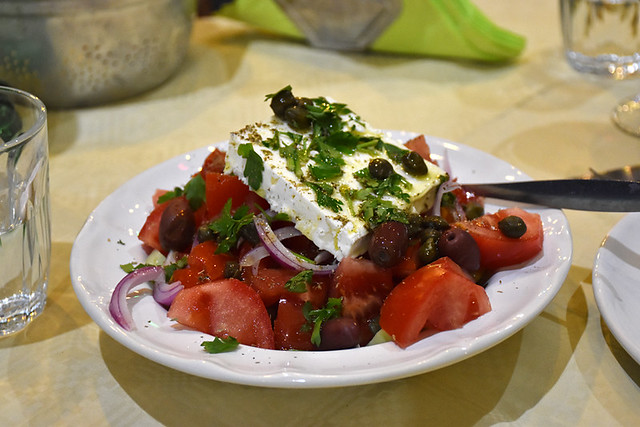The waiter placed the salad on the table in front of us; outside I could hear the water lapping at the stilts which kept the fish and seafood restaurant above sea level in pretty Portinho in Arrabida National Park.
In many ways it looked like a traditional tuna salad – a mini mountain of tuna piled on lettuce with sliced onion, tomato and cucumber providing back up. But there were a couple of other ingredients which added a fresh, summery burst of flavour; strawberries and oranges. Their presence transformed it, and made me think of a comment I’d read recently about another salad in a different seafood restaurant far, far away.

“Amazing tomato and onion salad with dressing.”
The praise lavished on the salad at a tiny fish restaurant tucked away in an alley near the harbour in Los Cristianos on Tenerife is something that regularly baffles me.
We’ve eaten the salad at El Cine and it consists of huge slices of beef tomato and onion with olive oil. Basic supermarket olive oil at that, nothing fancy. The tomatoes are fresh and tasty, but I’d be pretty hacked off if I was given a salad with ingredients which weren’t fresh. As salads go, it’s underwhelming.

I don’t know if some of the folk who declare a plate of onion and tomato as a salad to die for don’t normally eat proper salads. Maybe some palates are used to supermarket ingredients whose flavours have been jettisoned in favour of mass production and, to borrow a phrase from elsewhere, can really tell the difference when their taste-buds are introduced to locally grown produce. Possibly even peer pressure plays a part. If enough people say something is good, then it must be good.
But is it even a salad?

The OED defines a salad as being “a cold dish of various mixtures of raw or cooked vegetables, usually seasoned with oil, vinegar, or other dressing and sometimes accompanied by meat, fish, or other ingredients.”
Most definitions are similar. It leaves the door open for all sorts of interpretation. El Cine’s salad is minimalist in the extreme, but not in any deliberately fashionable way.

Any self respecting tomato salad is going to have a dressing which involves more than a waiter plonking a bottle of olive oil in front of you. It’s also going to include herbs such as basil and/or oregano. El Cine’s salad is nothing more than culinary laziness which is what irritates me most when I see it being praised. There’s been absolutely no effort put into its preparation.
I’m with the people at Bon Appetit who say “without a dressing, your salad is just a sad bowl of vegetables.”
When I order a salad I don’t want to feel as though I’m simply browsing the veg aisle of the local supermarket.

Salads are often gastronomic wallflowers, hanging about at the fringes of a meal; the dish nobody wants to dance with. And yet, with a little bit of imagination and not a lot of effort, they can be things of exotic beauty.
The Great British Chefs website advises “a beautifully presented salad as a starter or main meal can be a great way to impress your guests without requiring too much time in the kitchen.”

We’ve enjoyed the most wonderful salads on our travels; pretty little things which, as well as bursting with the freshness of whatever is in season, exude imagination – whether that’s strawberries in Austria or fesol beans in the Pyrenees. These aren’t fancy restaurants I’m talking about, they were traditional places. But the chefs put as much thought and care into their salads as they did other dishes.

Maybe perceptions are partly at the root of the problem with some salads – people expect them to lack personality. Researching what was considered to constitute a bad salad, it was interesting to note salads were classed as bad not because they were poorly constructed, they were judged as being bad if they had ingredients that were considered unhealthy. Why can’t my salad can be as unhealthy as any other menu item? None of the dictionary definitions dictate it has to be healthy to be classified as a salad.
This health tag can be a millstone; a licence for some to serve up something nutritionally righteous but terminally dull. I’m not suggesting we should be dipping rocket in batter and deep frying it or anything, just that the ‘healthy’ tag shouldn’t necessarily be what dictates the ingredients.

The irony is when I searched Google for recipes for boring salads, all I found were recipes for interesting salads. Switch to searching images for the same and what came up was anything but boring. In fact most salads in Google images looked great to me, showcasing the sort of salads I’d be happy to get to know in any restaurant.
Not one showed a plate which only consisted of chunky slices of onion and tomato… not even when I searched for a tomato and onion salad.

In the end what constitutes a good salad is obviously subjective.
You say tomato, I say… no thanks, I’d prefer a real salad.




Be the first to comment